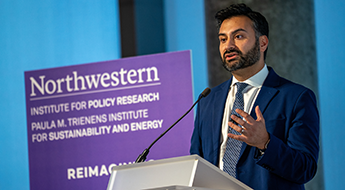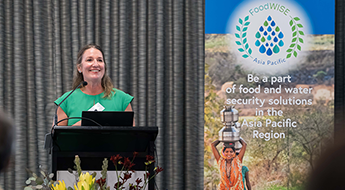The Lasting Mark of Shootings
IPR experts detail the sweeping effects on survivors and communities—and discuss policies to help prevent them
Get all our news
What we do know is that the assault weapons ban—it worked, and it worked really well. We don't need to search for some secret policy or some secret formula to stop mass shootings.”
Lori Ann Post
Demographer and IPR associate
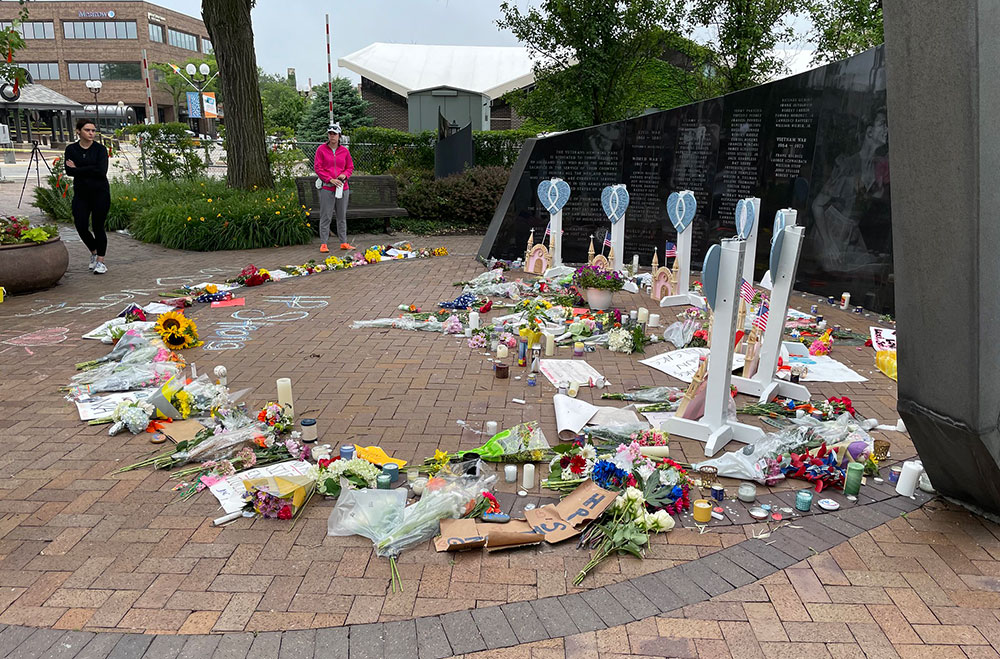
Residents visit a memorial to the victims of the July 4, 2022, shooting in Highland Park, Illinois.
Mass shootings have been on the rise in the U.S.—not just in schools like the Uvalde, Texas, shooting where 21 people were killed, but in places of worship, in grocery stores, and during family events like the recent July 4th parade shooting in Highland Park, Illinois, a few miles from Northwestern. And it was only one of the mass shootings in the Chicago area over the holiday weekend.
Despite Americans’ historically divided opinions around gun control, the Uvalde school shooting compelled Congress to pass the first bipartisan gun safety legislation in nearly 30 years. It also led some states to pass measures to arm teachers, add police in schools, and protect students.
But will these new laws prevent further shootings and gun violence as Americans go about their daily lives? And how will they help those who survive them?
In the wake of these tragedies, IPR faculty experts offer their research insights into the short- and long-term costs of school shootings for surviving students, how shootings change communities politically, and which evidence-based solutions could help prevent mass shootings.
Tracing the Enduring Effects on Students || Shifting Voter Behavior in Affected Communities
Preventing More Shootings || Supporting Survivors and Keeping Communities Safe
Tracing the Enduring Effects on Students
Recent data show school shootings with casualties reached a record high of 93 in 2020–21, with nearly half (43) resulting in deaths. And since the 1999 Columbine shooting, more than 311,000 students have been exposed to gun violence at school, according to the Washington Post. This includes high-profile shootings covered widely by the media as well as incidents without any deaths, such as a student bringing a gun to school. Researchers show that both types can inflict damage on students.
IPR economists Molly Schnell and Hannes Schwandt study how exposure to a school shooting affects students in the short- and long-term. Their 2020 study, published in the Proceedings of the National Academy of Sciences, looks at national data from 44 school shootings between 2006 and 2015. It finds that two years after the incident, antidepressant use increased over 20% among youth who were exposed to a school shooting.
“Our work shows that school shootings have lasting mental health impacts on students who are exposed to these events,” Schnell said.
Schnell and Schwandt note that mental health is important for economic and social outcomes throughout life, like maintaining a stable job and developing healthy relationships.
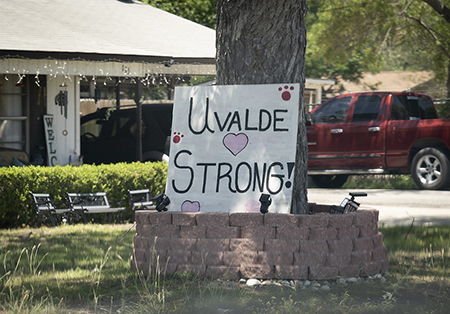
A yard sign posted in Uvalde, Texas, following the shooting at
Robb Elementary School on May 24, 2022.
In another study, Schnell, Schwandt, and their colleagues examine the costs of school shootings on students’ educational and economic trajectories. The researchers linked Texas administrative data from primary schools, high schools, universities, and the labor market, and then compared students who were attending 33 K–12 public schools in Texas that experienced a school shooting between 1992 and 2018 to students who attended a similar Texas school that did not.
In the two years following a school shooting, students who experienced one were more likely to miss school, be chronically absent, and repeat a grade when compared to their peers. Long term, these students were less likely to graduate high school or to attend and graduate from college. By their mid-20s, they were also less likely to be employed and earned less than their peers, which the researchers calculate could add up to $115,500 in lost wages over their lives.
“This is in line with larger economic literature showing that poor mental health has lasting impacts on educational attainment and labor market outcomes that can extend beyond the lasting impacts of poor physical health in childhood,” Schwandt said.
Schnell and Schwandt point out that these are calculations for a single student, and the estimated income losses across the number of students exposed to school shootings in recent years adds up to billions of dollars. Their work also reveals that these events can lead to higher teacher turnover, leading students to have more teachers with limited experience at their school.
“It could also affect the way students feel towards school,” Schnell said. “School is supposed to be a safe space. And once you have violence in a school setting, one could imagine that it could make students feel less comfortable or just not want to spend as much time there.”
Shifting Voter Behavior in Affected Communities
Beyond lifetime career and mental health consequences, research shows that a school shooting can also shift how people vote in communities where one occurred. Political scientist and IPR associate Ana Arjona and her colleagues, Laura García-Montoya (PhD 2020) and Matthew Lacombe (PhD 2019), investigate how.
“When we think about debates about what can be done to reduce school shootings, political action is very important, especially as polarization grows in the country,” Arjona said. “Looking at school shootings allows you to try to understand how people respond to a very particular form of violence.”
In the study, they examine voter turnout and voting patterns in U.S. presidential elections between 1980 and 2016 in counties that experienced a school shooting. In counties where 117 school shootings took place, voter turnout did not change, but these events increased support for the Democratic Party by an average of 5 percentage points at the county level. The shift was the same for shootings with and without fatalities.
“This is consistent with what we know based on surveys that a lot of the population supports some restrictions to gun ownership,” Arjona said, “but also that people can penalize politicians for not taking a stance on policy issues.”
The study also reveals that the amount of time that passed between a shooting and election day did not matter significantly: The passage of time did not affect either voter turnout or increase support for the Democratic Party—and neighboring counties were still more likely to vote for Democrats. These findings indicate that the effects of school shootings stick with communities for a long time, and how close one lives to a shooting can motivate a person to vote differently.
“We would expect to see that people in Uvalde would vote less for the Republican Party especially because Texas is a state where strict gun laws are lacking,” said Arjona. “And we would also expect to see nearby counties affected as well.”
She says the study results are surprising because gun control is a polarizing issue—and few people change their minds on policy positions, especially as polarization grows.
“What this signals is that people care about this … right after a shooting, and especially if the shooting is in their county or in a nearby county,” she said.
So what can be done to prevent shootings and their devastating consequences? In 1994, President Bill Clinton signed the Public Safety and Recreational Firearms Use Protection Act, also known as the Federal Assault Weapons Ban, into law. This decade-long ban on certain assault weapons and high-capacity magazines allowed researchers like IPR associates demographer Lori Ann Post and sociologist Maryann Mason to study its impact on mass shootings before, during, and after the ban.
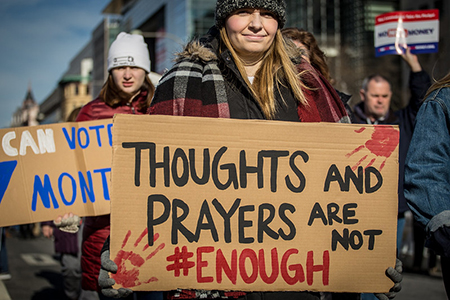
Protesters walk in the 2018 March for Our Lives protest.
Her research finds that the ban prevented 11 public mass shootings between 1994 and 2004. She also estimates that keeping the ban in place until 2019 would have prevented 30 public shootings that killed 339 and injured 1,139 people. Post says that researchers who study mass shootings have different definitions of mass shootings, use different methodologies, and come from different disciplines, but they all find that the assault weapons ban, including large capacity magazines, prevented mass shootings.
“What we do know is that the assault weapons ban—it worked, and it worked really well,” said Post. “We don't need to search for some secret policy or some secret formula to stop mass shootings.”
Mental health policies, such as the ones in the new bipartisan gun legislation, are often cited as effective ways to stop future shootings, but Post says addressing mental health will not stop mass shootings. She explains that people who have mental health conditions, such as depression or more severe conditions such as schizophrenia, often do not have the organizational skills to pull off a mass shooting. This stands in contrast to those with easier-to-hide personality disorders like narcissism or sociopathy who cannot be institutionalized.
“Some personality disorders present as having no empathy. It doesn't mean you're not aware of what you're doing,” she said. “[Mass shooters] have fantasies about killing, they have fantasies about how their name will be in the media. And those kinds of individuals can feign empathy. And I think it makes [mental health] screening harder.”
Post is currently working on research with mental health providers to understand the differences between mass shooters with personality disorders and those with other mental health conditions. Doing so, she says, will provide a better understanding of how accountability plays into the debate around mental health and gun legislation.
Supporting Survivors and Keeping Communities Safe
While mental health screenings may not flag potential mass shooters, researchers believe more resources are necessary to help survivors. Schnell and Schwandt say that their research shows the current interventions and resources devoted to school shooting survivors are not sufficient to counteract the negative fallout like struggling with depression or repeatedly missing class.
“Identifying effective interventions that can help mitigate the lasting consequences of exposure to gun violence in schools is a very important area for future research,” Schnell said.
Post notes that the perpetrators’ motives for mass shootings, regardless of where they take place, are often the same, so policies like banning assault weapons that will prevent school shootings will also stop other mass shootings. And while she is glad to see some policy movement on this issue among politicians and the public, she emphasizes how all mass shootings are a horrific loss of life and cause for policy action—and also sees ways for individuals to help prevent them.
“Mass shootings are the final act in an ongoing pattern of antisocial behavior over time. Because of their dearth of empathy, mass shooters are unable to form relationships or to even care for a pet,” Post explained.
Post says to end mass shootings, banning assault weapons should be paired with action from community members such as notifying the police if they see alarming behavior from others, including acts of violence, threats, and social media posts that glorify violence.
“We need to have a unified community response that allows individuals to make reports of concerning and alarming behavior that is actionable by police agencies so they can act and put such individuals on their radar,” Post said. “Persons with ongoing, escalating deviant and antisocial behavior should never have access to weapons.”
Molly Schnell is an assistant professor of economics and an IPR fellow. Hannes Schwandt is an assistant professor of human development and social policy and an IPR fellow. Ana Arjona is an associate professor of political science and an IPR associate. Lori Ann Post is the Buehler Professor of Geriatric Medicine, director of the Buehler Center for Health Policy and Economics, and an IPR associate.
Photo credits: Flickr, Hajee; Flickr, U.S. Department of Homeland Security; Flickr, P. Roeder
Published: July 8, 2022.

